黎
章
廣
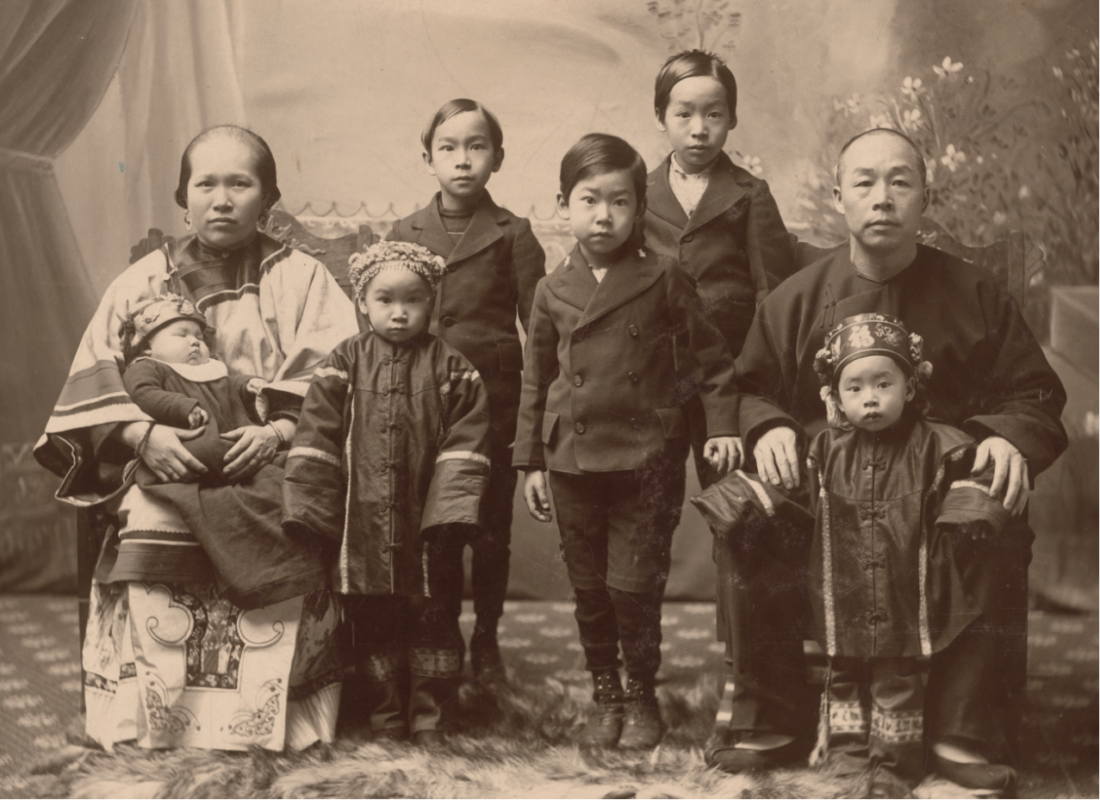
George Lai Sun Family. Oregon Historical Society Org Lot 480. Norma O’Kelley Collection. Given the ages of the children in this image, likely taken after Bessie Lai Sun was born in November 1900. Left to Right: Leong Hong holding Bessie Lai Sun, Mary Lai Sun, Lai Woo Sun, Suie Lai Sun, Lai Yee Sun, George Lai Sun with Esther Lai Sun.
Lai Hung Sun (also known Lai Sun, George Lai Sun, George Sun, Lai Jeong Quong, Lai Gong Kwon)[1] was born in the Noah Mah Yeng village in Taishan, Guangdong, China[2] on 17 January 1849.[3] Like many young men in the Guangdong region at the time, he sought economic opportunities on the West Coast of the United States. He arrived at Portland in about 1868 and soon made his way to the Salem area.[4] The earliest Census record he can be positively identified in is the 1880 Census, where he is living on Liberty Street and working in the laundry business.[5]
Lai Sun would make at least two trips back to China in about 1881 and 1885. During the first trip he married Leong Hong. The two would make separate trips back to the United States, arriving through the port of San Francisco and making their way overland to Salem.[6]
The couple settled into the Bennet House on the northwest corner of High and State Streets, where Lai Sun returned to his laundry business (located in the building) that he had temporarily sold during his sojourn back to China.[7] Their lives were upended when the building caught fire two years later. The pair had to jump out of the window to save their own lives. Sadly, three of their neighbors perished in the conflagration.[8] Not daunted by the hardships, Lai Sun fixed up a building just west of the fire site and continued his business.[9]
His proprietorship of the laundry and later a merchandise store[10] and as a hop grower[11] gave Lai Sun special status as a merchant under federal immigration rules and allowed him to bring his wife to the United States, unlike many of his neighbors. As Lai Sun recalled in a 1929 Immigration Interview: “My wife was landed at San Francisco as a merchant’s wife.”[12] The couple had 10 children born in Salem, sons Lai You (1887), Lai Yee (1888/9), Lai Woo (1890), Lai Suie (1894), and Lai Hem (1905) and daughters unnamed infant girl (1893), Lai Choon Lon (Mary) (1897), Lai Choon Oye (Esther) (1898), Lai Choon Gum (Bessie) (1900), Lai Chong Fun (Maxine) (1911).
In addition to his business interests, Lai Sun also was a leader within the Chinese American community in Salem. When the registration provisions of the 1892 Geary Act requiring individuals of Chinese heritage to carry registration papers, he was one of the leaders in Salem to be interviewed and urge others to resist the initial registration orders.[13] In newspaper coverage his is often described as the “mayor of Chinatown.” It should be noted that this was not an actual office, and while on the surface this seems like an honorific title and definitely represents the leadership role he served, it is hard to read the tone of the articles in which it is used.[14]
Lai Sun also recognized the social and political disparities he faced. During a birthday party for Hal Patton in 1922, many members of the community got up to give toasts. The speeches that night were written down in a commemorative booklet, a copy of which is housed at the Willamette Heritage Center. In his speech, George Lai Sun is recorded as saying:
“I have been here so long, fifty-four years next June. I ought to be a citizen. I out to be voting, too.”[15]
The Lai Sun family moved to Portland after their store was razed to make way for a new building on the northwest corner of High and Ferry Streets in Salem.[16] Lai Sun died at his Portland home (265 East 15th St) on December 16, 1932.[17] His Oregon Statesman obituary describes him as “honest and upright in all his dealings” and an “enterprising and good citizen.”[18]
Citations
[1] Lai Sun is consistently the name given by this individual when asked his name. As we will try to note within the context of the article, differences in cultural naming practices and transliterations lead to a variety of names and spellings within the written record. The additional practice of adopting an anglicized name can also add to confusion. Lai Sun. Lai Hung Sun is the transliterated birth name given to this individual. Lai would be his family name and Sun his given name. He also states in that his married name was Lai Jeong Qong/Lai Gong Kwon. In the U.S. he also adopted the anglicized name of George Sun, sometimes George Lai Sun. See
Chinese Exclusion Act Case File for Mary Fong (NARA 5017/623) interview conducted 27 Aug 1931 Portland
What are all your names? A. Lai Sun; marriage name Lai Jeong Qong; I am known to white people as George Sun.
Chinese Exclusion Act Case File for Hem Lai Sun (NARA 5017/719) interview conducted 20 Nov 1929 through interpreter Herman Lowe.
What are your names? A. Lai Hung Sun; marriage name Lai Gong Kwon. I am known as George Sun.
In Hem Lai Sun’s Interview at same time: What are the names of your father and mother? A. My father’s name is Lai Hung Sun. They call him George Sun.
Chinese Exclusion Act Case File for Maxine Lai Sun/Lai Chong Fung (NARA 5017/553) interview conducted 19 June 1930 through unnamed interpreter
What are your names? A. Lai Sun; also known as George Sun.
Chinese Exclusion Act Case File for Woo Lai Sun (NARA 5017/249) Interview conducted 29 April 1916 in Salem with Inspector W.F. Watkins.
Woo Lai Sun: Everybody knows my father as George Sun, but his right Chinese name is Lai Sun. The teachers at school called me Woo Sun, using the given name of my father. I now sign myself as Woo Lai Sun…)
Lai Sun: What is your name? A. Lai Sun; I am also known as George Sun.
[2] The village spelling is consistent in at least two of the interviews done with Lai Sun during his lifetime. Transliteration from Chinese characters mean that village information is sometimes spelled in a number of ways in the records. According to an interview in Chinese Exclusion Act Case File for Mary Fong (NARA 5017/623) interview conducted 27 Aug 1931 Portland, he claimed he was born in the Noah May Yeng Village, Sun Ning District, China.
Sun Ning is a spelling transliteration (新寧) of a county now known as Taishan ( 臺山). Wikipedia https://en.wikipedia.org/wiki/Taishan,_Guangdong.
See also
Chinese Exclusion Act Case File for Hem Lai Sun (NARA 5017/719) interview conducted 20 Nov 1929 through interpreter Herman Lowe. When and where were you born? …I was born in No May Yeng Village, Sunning District, China.
[3] Death Certificate (Multnomah County) (Ancestry.com)
Place of Death: 265 East 15th Street (Portland)
George Lai Sun. Date of Birth 17 Jan 1849. Age 83 years, 10 months, 29 days.
Date is also printed on his tombstone at Lincoln Memorial Park (Portland). 1849-1932.
However, it should be noted he gives his age in a 1931 Interview (Chinese Exclusion Case File for Mary Lai Fung 5017/623 as 81 on August 27, 1931; Similarly Chinese Exclusion Act Case File for Hem Lai Sun (NARA 5017/719) interview conducted 20 Nov 1929 through interpreter Herman Lowe. Lai Sun states: When and Where were your born? A. I will be 80 next January.
[4] The 1868 date of arrival comes from Lai Sun’s obituary. “Sun, once head of Chinatown, is dead.” Oregon Statesman 20 December 1932 pg 8. “Mr. Sun came from China direct to Salem in 1868.” In the Hal Patton Memorial Booklet (WHC 0081.022.0001 dated January 12, 1922,), George Lai Sun states: “I have been here so long, fifty-four years next June.” That would back up the arrival date of 1868.
Note that in interviews with the Immigration Office testifying to his children’s nationality he states various other dates are posited, sometimes conflicting within the same set of interviews.
Woo Lai Sun Exclusion Act Case File NARA 5017/201. Interview with Lai Sun 29 April 1916:
When did you first enter the United States? A. I came to Portland forty-six years ago, and a few days afterward came up here. This would suggest an immigration date of 1869/70.
Hem Lai Sun Exclusion Case File NARA 5017/719 Interview with Lai Sun 20 Nove 1929 through Herman Lowe Interpreter. Q: When did you first enter the United States? And where did you land? A. T.C. 10, landed at Portland. Assuming T.C. refers to reign of Tongzhi Emperor (1861-1875), that would provide a landing date of 1871 approximately. Note that in the same case file, Hem Lai Sun is interviewed and states: Q When were you advised that your parents moved to Salem? A. My father came to the United States in 1851, but I don’t know when they moved to Salem to live.
Mary Fong Exclusion Act Case File NARA 5017/623 Interview with Lai Sun through Herman Lowe Interpreter 27 Aug 1931. Q. When did you first come to United States? A. Almost 60 years ago; I forgot the exact date. Q. In 1916 you testified that you came here in approximately the year 1870; would that be correct? A. I came during the reign of Tung Gee [Tongzhi 1856-1875 – https://en.wikipedia.org/wiki/Tongzhi_Emperor].
Additional sources indicate other dates.
“They were Discharged.’ Oregon Statesman25 Oct 1888 pg. 3
… George Sun has been a resident of Salem for seventeen years, and has always been found honorable in his dealings, both with his own countrymen and with Americans….” Would give an arrival date in Salem as 1871
1900 US Federal Census gives an immigration date of 1869. 1910 Census – 1873. 1920 Census – 1871. 1930 Census – 1870.
“Lai Yick to Host His Friends.” Oregon Statesman07 Feb 1922 pg. 6
….”George Sun also told of his arriving in the city in 1869 and how he was in the Benett hotel fire and barely escaped with his wife.
[5] 1880 US Federal Census. Salem, Oregon.
[6] Woo Lai Sun Exclusion Act Case File NARA 5017/201. Interview with Lai Sun 29 April 1916:
Q Have you made any trips to China since your first arrival in this country? A. Yes, twice. I went back to China. I stayed about six months and came back in a few months and landed at San Francisco. Q. Did you bring anyone with you on that trip? A. No. My wife came, maybe a year later, with another Chinese Lady. Q. IN your statement to Inspector Sawyer on 12 Oct 1910, you stated that you and your wife came to the United States together in K.S. 10. A. We didn’t come together, but I went to San Francisco to meet her and we came to Salem together. Hem Lai Sun Exclusion Case File NARA 5017/719 Interview with Lai Sun 20 Nove 1929 through Herman Lowe Interpreter. Q: What trips have you made to China? A. Two trips, the first come in K.S. 7, second trip in K.S. 10.
Based of this information, likely trips back to China happened in c.1881 and 1885. K.S. referring to Kwangsu — Guangxu Emperor (14 August 1871 – 14 November 1908) https://en.wikipedia.org/wiki/Guangxu_Emperor. This is backed up by notice placed in the Oregon Statesman 6 October 1885 upon his return to Salem from trip to China.
[7] 1885 06 October Oregon Statesman:
Notice: Before Leaving Salem for China, I sold my wash business to Howe Way, having returned to Salem to reside Permanently, I have bough Hoe Way out, and will resume business at my old stand on the first day of September, 1885. Will be pleased to meet all of my old customers at my old stand, Bennett House corner Geo. Sun.
[8] “A Big Blaze” Oregon Statesman 21 January 1887 pg. 3 (newspapers.com)
…Many of the inhabitants barely escaped with their lives. George Sun and wife, near whose room the fire started, found safety only in jumping from the window in their night clothes.
[9] “Into New Quarters.” Oregon Statesman 15 March 1887 pg. 3. George Sun, proprietor of the old City Laundry, which was burned out in the Bennett House fire, is fitting up the old building just this side of the scene of the fire, and will open up his store there as soon as possible.
[10] 1900 and 1910 Federal Census list George Lai Sun as a merchant running a merchant and running a grocery and drug store. 1916 Interview with Inspector W.F. Watkins 29 April (NARA Case File 4589 for Woo Lai Sun)
George Sun Testimony
Q: What is your Occupation?
Merchant, manager, Yee Lee Co., general Chinese merchandise
[11] “The Growers and the Buyers.” Weekly Oregon Statesman 30 Aug 1895 pg. 9. (Newspapers.com) “George Sun, the Chinese capitalist of this city, is the lessee of the yards and has notified his pickers to be ready for work by next Monday.” “Hops Contracted at 10 cents” Weekly Oregon Statesman 01 Jan 1897 pg. 2. (Newspapers.com) F. Levy and George Sun (to the above company) 25,000 lbs; “Hop Growers in Attendance.” Capital Journal 28 Oct 1914 pg. 6. (Newspapers.com) “George Sun, Salem.” “Are Now Happy” Oregon Statesman 11 March 1905 pg. 2 (Newspapers.com). “George Sun, the Chinese merchant, who has had years of experience in hop raising, recognized these conditions, and, although he had a force of about 15 men on salary and expenses in his hop yard, he allowed them to remain in idleness to avoid the consequences of too early working in anticipation of an abrupt change of weather.”
[12] 1929 Interview – Chinese Exclusion Act Case File for Hem Lai Sun 5017/531. Interview conducted in Portland, Oregon November 20, 1929. Herman Lowe Interpreter. Repository of Original Document: National Archives and Records Administration.
[13] “They will not register” Weekly Oregon Statesman 14 April 1893 pg 9 (newspapers.com)
[14] “They will not register” Weekly Oregon Statesman 14 April 1893 pg 9 (newspapers.com); “A Runaway” Oregon Statesman 15 Jul 1894 pg 5 (Newspapers.com) “Prominent Salem Chinese to Host To Score of Friends” Capital Journal 6 February 1922 pg 8 (Newspapers.com) “George Sun, often called the mayor of Chinatown here, gave an impressive demonstration of the workings of the Oriental mind in his reminiscent address.” Uses for other individuals: “Smoke Dream Pipe” Oregon Statesman 6 Februray 1914 pg. 2 (Newspapers.com)
[15] WHC 0081.022.0001 dated January 12 1922
[16] 1924 Salem City Directory shows Lai Sun’s merchandise store at 195 S. High Street. The Sanborn Fire Insurance Map (1895, updated through 1915) shows the store at the NW corner of High and Ferry streets, facing High Street. The current building was completed in 1924 (see “Modern Business Block Replaces Chinatown” Capital Journal 26 Jan 1924). The 1930 US Federal Census shows Sun and family living at 265 East 15th Street in Portland.
[17] Multnomah County Death Certificate (son Woo Lai Sun, information).
[18] “Sun, once head of Chinatown, is dead.” Oregon Statesman 20 Dec 1932 pg 8 (Newspapers.com). Note the irony that Lai Sun was never allowed to naturalize and the individuals born in China would not be afforded the right to naturalize until the 1940s.
George Lai Sun Family Tree
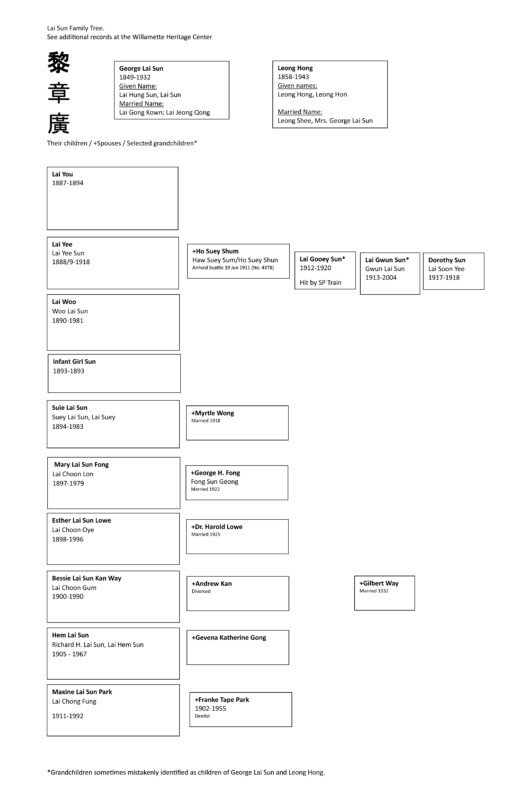
Learn More
Fitzgerald, Straus, Pine. “Searching for Salem’s Early Chinese Community.” Oregon Historical Quarterly Volume 122, No. 4. Winter 2021
George Lai Sun Family Sourcebook. Willamette Heritage Center. Contains copies of National Archives Records Administration ordered Chinese Exclusion Act Case Files ordered for known family members.
Learn more about experiences of individuals of Chinese Heritage in Salem here.
Suie Lai Sun’s Remembrances of Qing Ming Celebrations in Salem, as written by Ann Lossener

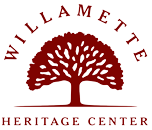
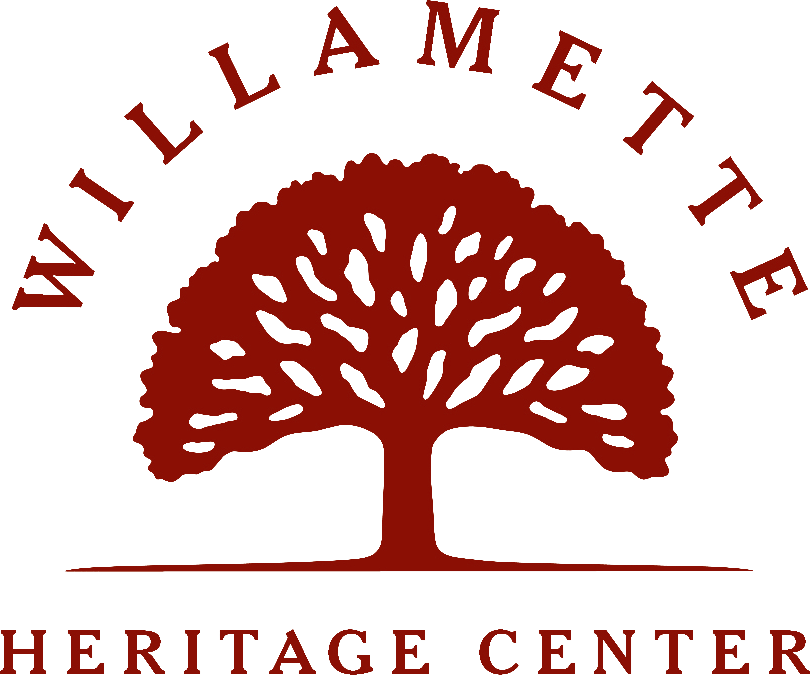
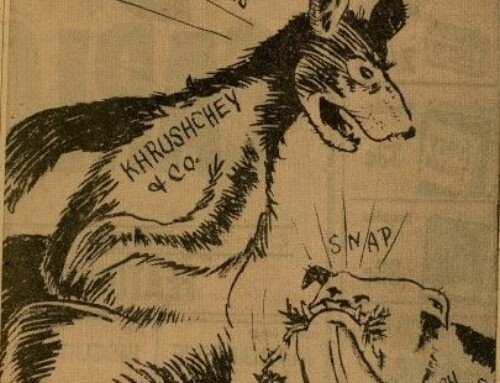
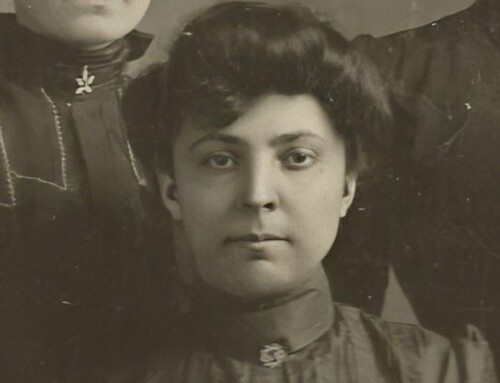
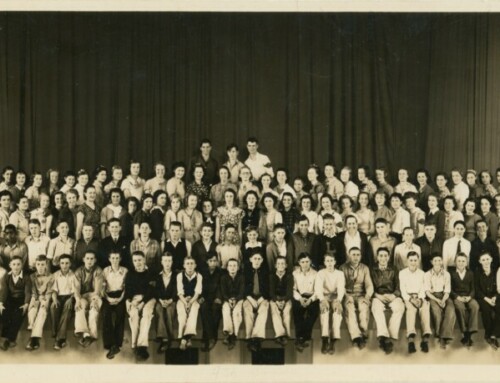
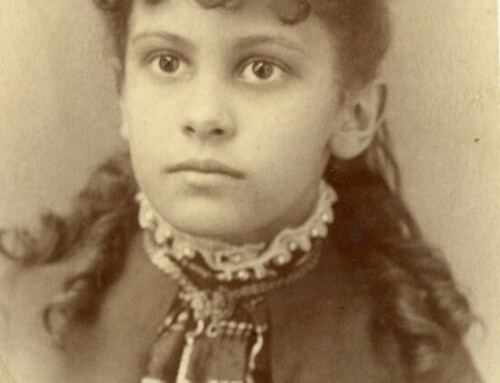
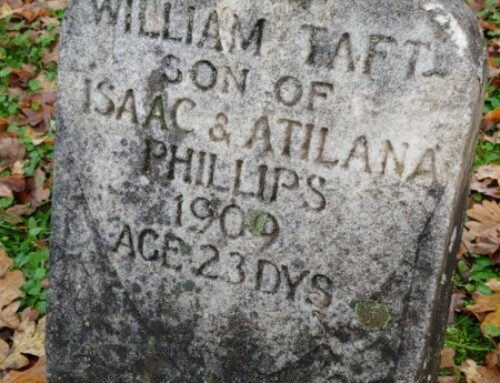
Leave A Comment